2021 Volkswagen ID.4 Review: The People’s Electric Car
The first of many electric vehicles from Volkswagen, the new ID.4 marks a pivotal point for Volkswagen and the automotive industry.
Capital One
Translated, Volkswagen is said to mean “the people’s car.” The original Type 1, also known as the Beetle (or Bug), personifies the concept. The small, reliable, and affordable Beetle, following its ignominious origins, went on to sell more than 21.5 million copies in over 65 years of production.
Now, Volkswagen introduces a new car for the people. The 2021 Volkswagen ID.4 is electric and offers up to 260 miles of driving range on a single charge. It’s also not a car, according to Volkswagen. Instead, it’s a compact crossover SUV — nevermind that it comes with standard rear-wheel drive (RWD) and offers no more than 6.1 inches of ground clearance. Based on an electric vehicle (EV) platform that can spawn an army of Volkswagen-badged electrics, the ID.4 is as critical to the automaker’s success in America as was the original Beetle.
Available in Pro and Pro S trim with RWD or all-wheel drive (AWD), prices range from about $40,000 to about $50,000 before factoring in the maximum $7,500 federal income tax credit, and any available state and local incentives and rebates. Volkswagen also claims that an ID.4 saves about $4,000 in fuel costs over five years using average values for gasoline and electricity. Competitors include the Chevrolet Bolt EUV, Ford Mustang Mach-E, Hyundai Kona Electric, Kia Niro EV, Nissan Ariya, and Tesla Model Y.
Volkswagen provided an ID.4 Pro with RWD for this review — the basic version of the new “people’s car”. We spent a week living with this new electric ID.4 and found it an excellent commuter vessel and errand-runner, especially if you upgrade your home with an 11-kW Level 2 charging solution.
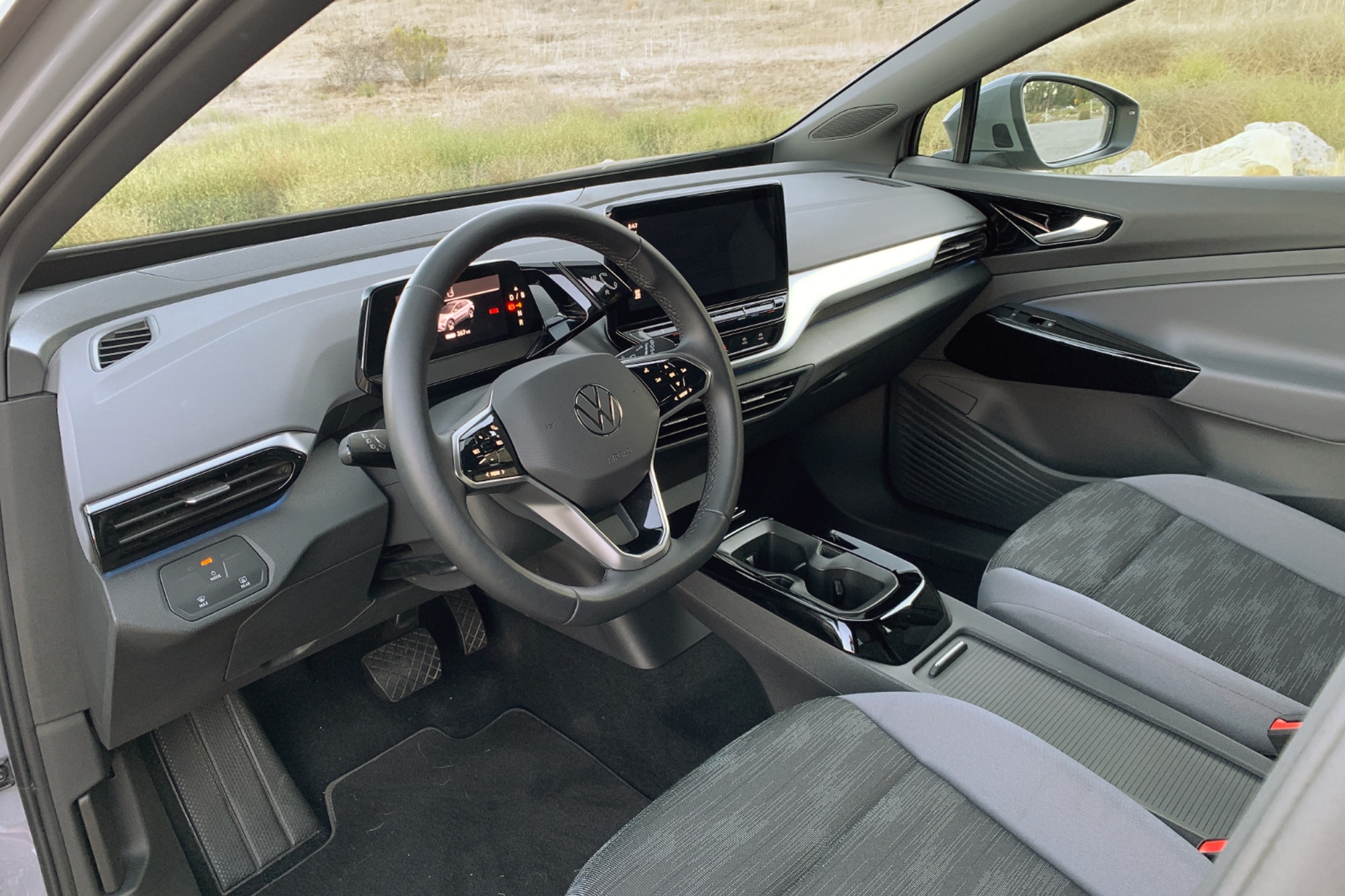 Christian Wardlaw
Christian Wardlaw
MINIMALISM RULES IN THE ROOMY, HIGH-TECH INTERIOR
Electric vehicles need to be aerodynamic to maximize their efficiency. The ID.4’s 0.28 coefficient of drag comes courtesy of a clean, flowing design and close proximity to the ground, with gray lower cladding primarily responsible for qualifying the vehicle as an SUV. A Gradient option package is available with Pro S trim, installing attractive 20-inch wheels, a black-painted roof, and silver roof rails for a premium appearance.
Walk up to the ID.4, and it senses the key fob so that when you use the door release pad under the fixed handle, the vehicle unlocks and opens. Volkswagen has completely rethought how the ID.4’s controls should work, from those exterior door handles to the transmission shifter. Interior design is a study in minimalism: futuristic and daunting to the uninitiated.
If you’re familiar and comfortable with modern technology, you’ll pick things up in no time. However, many features and functions are touch-sensing and hard to use smoothly given the ID.4’s firm ride quality. The way the car wakes up and is ready to drive once you sit down also takes some getting used to. Similarly, when you leave the ID.4, it goes to sleep without any action on your part aside from exiting the vehicle. This aspect of the car’s technology is particularly unconventional in comparison to traditional vehicles.
Volkswagen expertly matches and pairs the ID.4’s surface textures and tones for a cohesive look per usual. In addition, soft-touch material covers the top of the dashboard and door panels. The ID.4 Pro S interior offers greater visual contrast than the standard ID.4 Pro cabin.
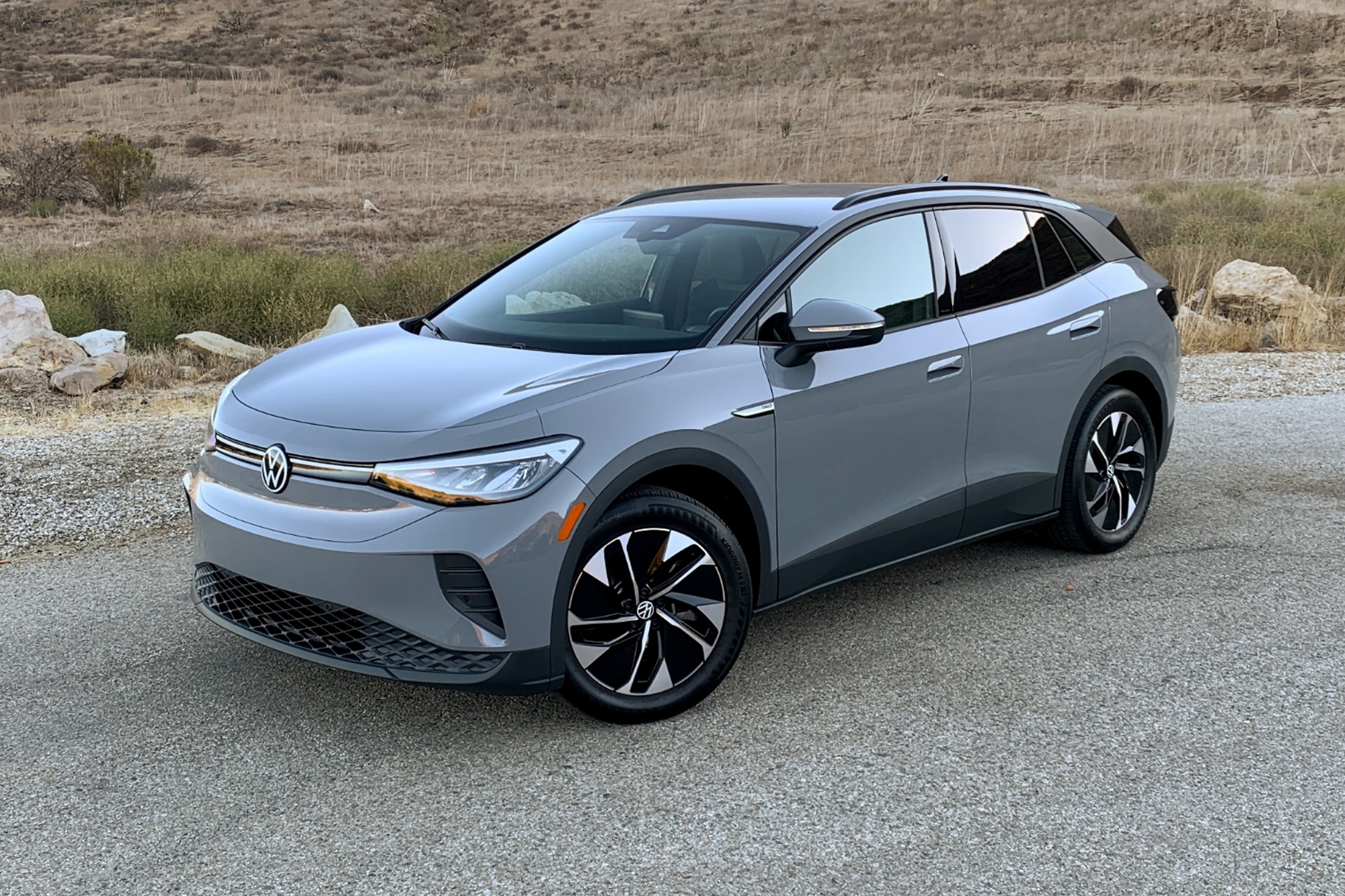 Christian Wardlaw
Christian Wardlaw
Soothing ambient lighting is standard, with impressive execution in combination with the digital instrumentation and infotainment displays. Volkswagen also equips the ID.4 with something called ID.Light, an illuminated strip of lighting that runs along the base of the windshield providing visual alerts and feedback to inputs.
The test vehicle had cloth seats with an appealing insert pattern. Both front seats offered heating and manual height adjustment to help maximize comfort. Inboard armrests make the front seats look and feel more like captain’s chairs, but they can get in the way when the driver turns the steering wheel. Upgrade to the ID.4 Pro S for 12-way power-adjustable front seats with lumbar massage and Volkswagen’s V-Tex perforated leatherette upholstery.
A cleanly styled and practical center console resides between the front seats, but it’s mounted relatively low. While Volkswagen might have taken this route to preserve the ID.4’s open, welcoming, and airy ambiance, some people may prefer a taller and deeper storage solution.
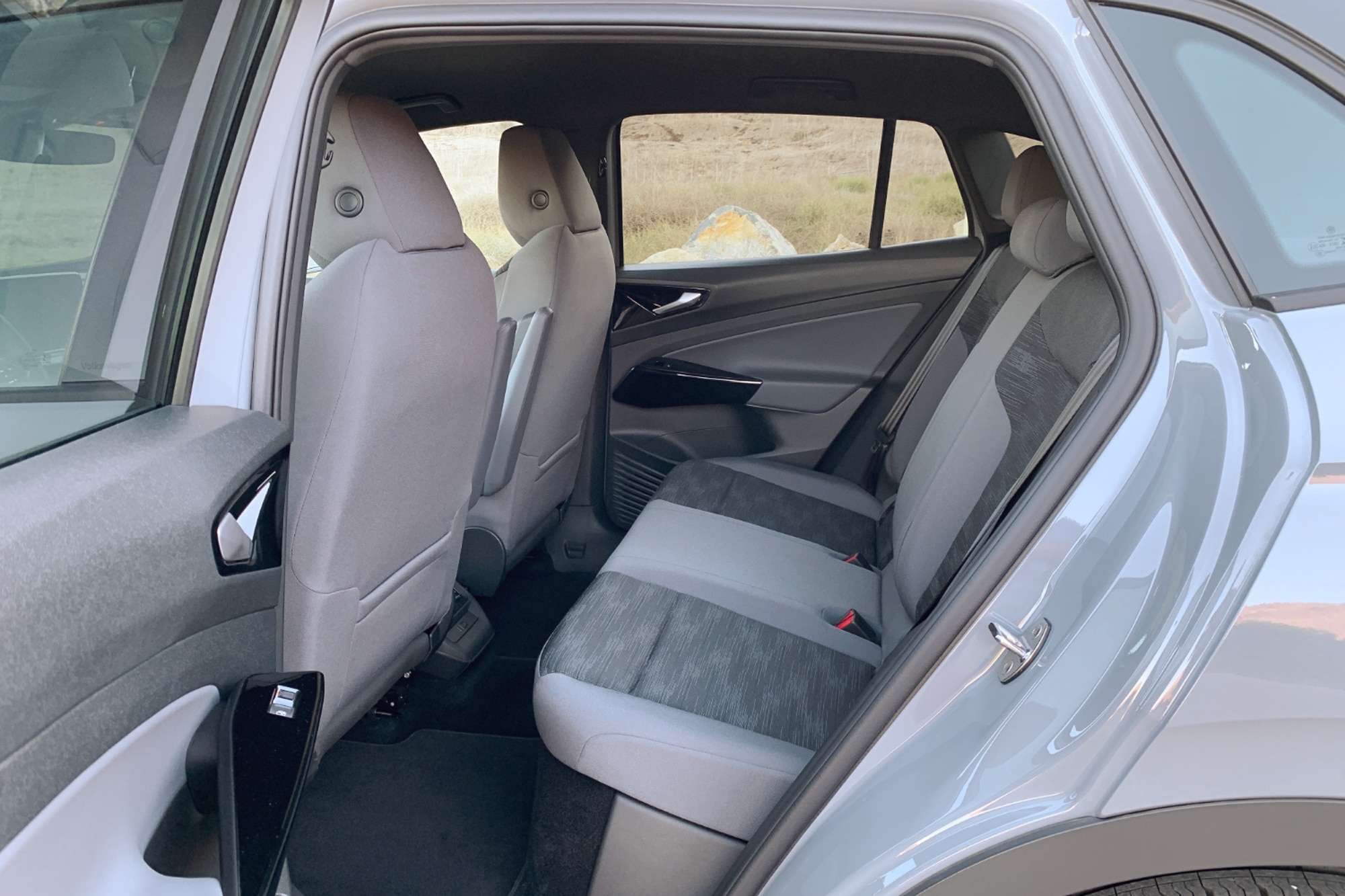 Christian Wardlaw
Christian Wardlaw
Rear passengers can enjoy plenty of room and support for their legs. Storage is primarily limited to the front seatback pockets and bottle holders in the lower door panels. You’ll need Pro S trim to get a rear center armrest with a cargo area pass-through panel, but standard equipment includes air vents and USB charging ports.
 Christian Wardlaw
Christian Wardlaw
Volkswagen includes a hands-free power rear liftgate with Pro S trim. The ID.4’s trunk is deep with a flat load floor and an underfloor storage compartment for the charging cable. The cargo space behind the back seat measures 30.3 cu.- ft., but folding the rear seat down can maximize volume at 64.2 cu.-ft. A strap on the left wall can also securely hold bottles of beverages after a grocery trip.
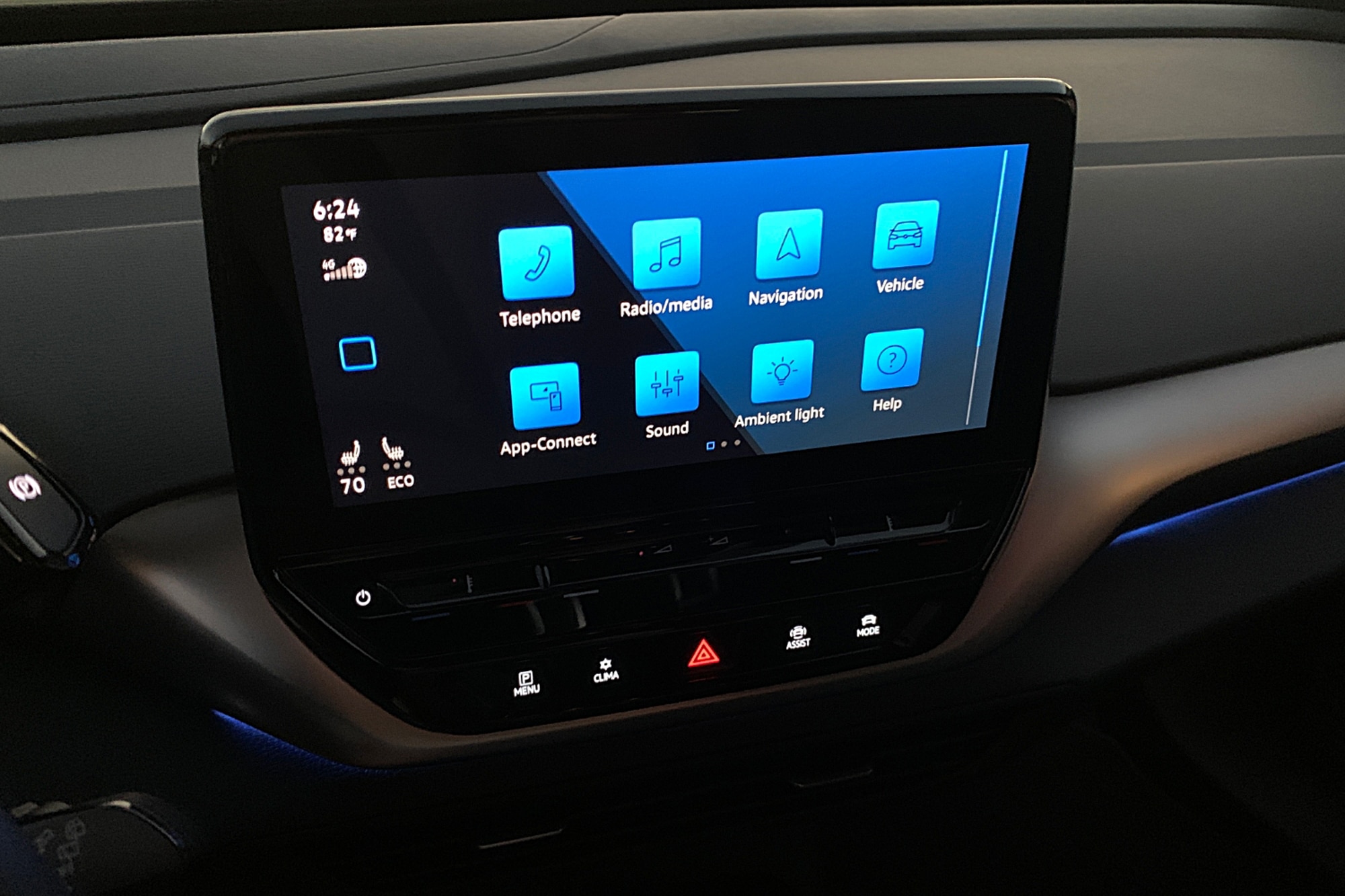 Christian Wardlaw
Christian Wardlaw
NEW, YET FAMILIAR, APPROACHES TO INFOTAINMENT AND SAFETY
It may seem complex, but don’t let the Volkswagen ID.4’s graphically pleasing display screens, touch-sensing controls, and interior layout deter you from choosing this vehicle. There can be a steep learning curve associated with the controls, their operation, and the technology. However, with some time behind the wheel, it mostly becomes second nature.
Every ID.4 has ID.Cockpit, a relatively small but configurable digital instrumentation panel. To the right of this on the dashboard, the ID.4 Pro has a 10-inch touchscreen infotainment display (12 inches with Pro S trim). Below the screen is a touch-sensing panel controlling temperature and stereo volume, and below that are four virtual buttons. These buttons provide access to the Home screen, deeper climate system functions, driving assistance settings, and driving modes. Oddly, a premium sound system to replace the merely adequate standard stereo speakers is unavailable for the ID.4.
A complimentary three-year subscription to Plus Speech EV voice recognition is part of the ID.4’s standard Car-Net connected services technology. Using a “Hello ID” prompt, it wakes the digital assistant without pushing the talk button on the steering wheel. The technology worked well, but had trouble finding reggae music on satellite radio (channel 19) and could not provide directions to a favorite local restaurant solely using the name of the establishment and the street on which it is located.
It’s worth noting that the driving assistance system menu pops up on the screen only when the ID.4 is in gear, but when the vehicle is moving, you can’t make changes to the settings. Aside from this, the ID.4’s standard IQ.Drive collection of advanced driving assistance systems is impressive.
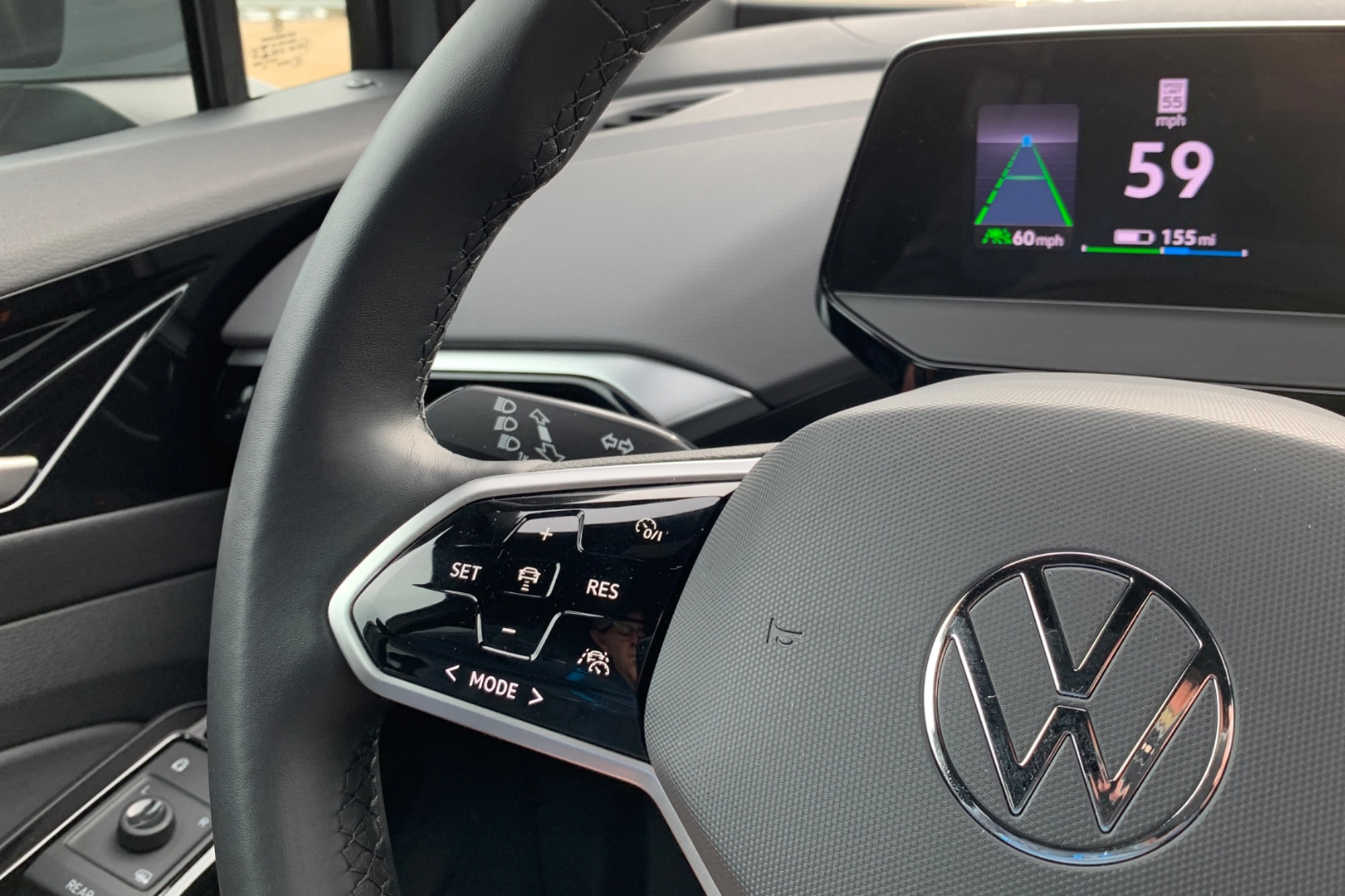 Christian Wardlaw
Christian Wardlaw
Overall, IQ.Drive operates in a smooth and sophisticated fashion. It includes Travel Assist technology, which combines adaptive cruise control with a lane-centering function. It works similar to other Level 2 semi-autonomous driving aids, though the steering assistance is more subtle than you might experience with other systems.
That same subtlety is evident with the Lane Assist system, which is lane-keeping assistance without the centering function. When you cross a lane marking, you get a steering wheel vibration and a slight tug to nudge you back toward the center of the lane of travel. It can get a little confused at times, such as when two travel lanes narrow to one. Also, when you’re driving on a two-lane road and you’re trying to give cyclists some extra room, you may need to muscle the steering a little to override the lane-keeping function.
Emergency Assist is also part of the IQ.Drive collection and is quick to engage if the driver lets go of the ID.4’s steering wheel. When this technology does not detect a driver’s hands on the wheel, it assumes they are asleep or suffering a medical emergency and brings the car to a safe stop in the lane of travel. It works both with the standard adaptive cruise control and the Travel Assist system.
If IQ.Drive cannot prevent a collision from occurring, the ID.4 will do its best to protect you from harm. According to the Insurance Institute for Highway Safety, it gets a “Top Safety Pick+” safety rating. Additionally, the National Highway Traffic Safety Administration gives the ID.4 its top overall rating of 5 stars.
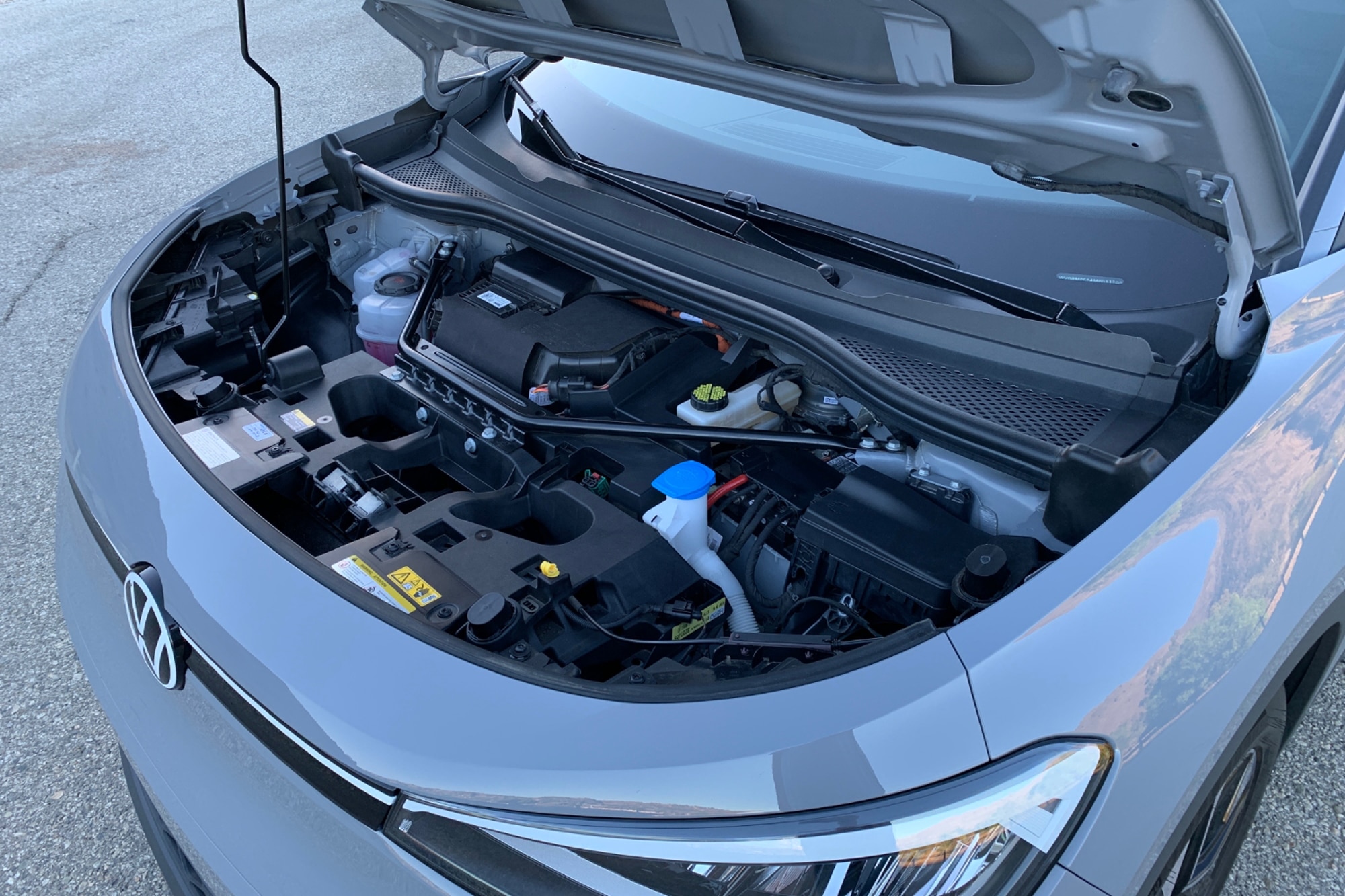 Christian Wardlaw
Christian Wardlaw
TYPICAL EV DRIVING DYNAMICS, WITH AN EXTRA LAYER OF REFINEMENT
Two distinctly different versions of the Volkswagen ID.4 are available*. The first is the RWD model. It has a single rear-mounted AC permanent magnet synchronous electric motor powered by an 82 kWh (77 kWh net) battery pack. In this configuration, the 4,559-lb. ID.4 has 201 hp and 229 lb.-ft. of instantly available torque.
With AWD, the ID.4 adds a front-mounted AC permanent magnet asynchronous electric motor. It bumps total power output to 295 hp and 339 lb.-ft., and Volkswagen says this version of the SUV accelerates to 60 mph in under 5.5 seconds. It is a variable system, engaging only when needed to improve traction or performance. With the added motor, curb weight jumps to 4,782 lbs.
The driving range varies depending on the drive unit, equipment, and selected driving mode. However, the Environmental Protection Agency estimates range between 240 miles and 260 miles. Efficiency estimates are 34 kWh/100 miles to 36 kWh/100 miles.
During testing in occasionally mountainous terrain, driving the ID.4 with engine braking on and in the Comfort mode, the ID.4 averaged 33.3 kWh/100 miles. The 149-mile drive started with 250 miles of indicated range and ended with 83 miles remaining, a shortfall of 18 miles compared to the initial estimate.
Recall that you don’t push a button to turn on the ID.4 and set off to drive. Instead, it senses when you have the key fob with you and activates when you sit down in the driver’s seat. The instrumentation and infotainment displays come to life, and the car is ready to go. You choose Reverse and Drive using a knob mounted to the right side of the instrumentation panel. A button in the center puts the ID.4 in Park.
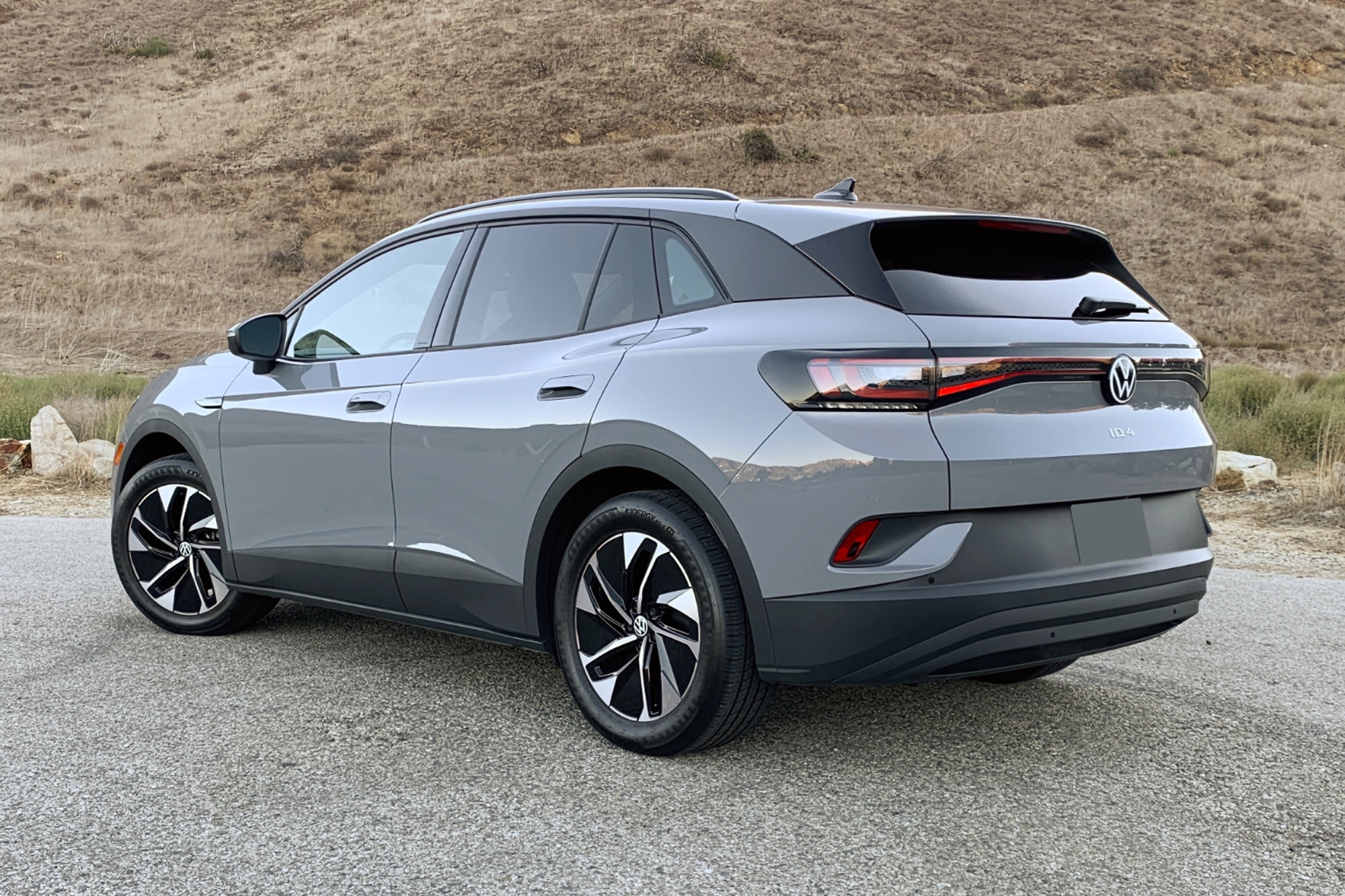 Christian Wardlaw
Christian Wardlaw
Once you’re in gear, simply push on the accelerator pedal and off you go. The driving experience is especially unique with an internal combustion engine. At 20 mph or less, the ID.4 emits a futuristic whirring noise to notify pedestrians that an electric vehicle is nearby. Accelerate from a stop, and the ID.4 whooshes silently to speed, quickly gathering enough velocity to merge onto freeways. Passing power is good, too, and on smooth pavement, the ID.4 is remarkably quiet on the highway.
If you twist the transmission knob again, like you’re trying to engage Drive a second time, an engine braking feature activates. It captures energy when the ID.4 is coasting and feeds it back to the battery. It’s pretty aggressive, so you can easily slow down in advance of red traffic lights or stop signs. However, it is not a one-pedal driving system. Once the ID.4 drops to 3 mph or so, the braking function turns itself off.
Volkswagen says the ID.4’s battery pack weighs more than 1,000 lbs. That’s a bunch of weight snugged low in the platform, which aids handling thanks to a lower center of gravity. However, it can also negatively impact ride quality. To solve for this, the ID.4’s suspension features a firmly-tuned strut-type front and multi-link rear configuration, and the standard 19-inch aluminum wheels are wrapped in staggered width 235/55 front and 255/50 rear tires.
Like with most electric vehicles, the driver can sense all of the weight under the cabin. Mainly, it manifests itself in a stiff, sometimes choppy ride quality. However, compared to shorter wheelbase electrics, the ID.4 is more agreeable in this respect. Also, the turning circle is remarkably tight at 31.5 ft.
Overall, the Volkswagen ID.4 is pleasing to drive. The steering lacks feel but displays unwavering confidence on center and is easy to use at low speeds such as when parking. Also, the brakes are occasionally sticky when driving in traffic, preventing smooth and clean stops. Although generally, the ID.4 makes a convincing argument for going electric. Just remember that even with AWD, this Volkswagen supplies no more than 6.1 inches of ground clearance, so it’s a good idea to keep it on the pavement.
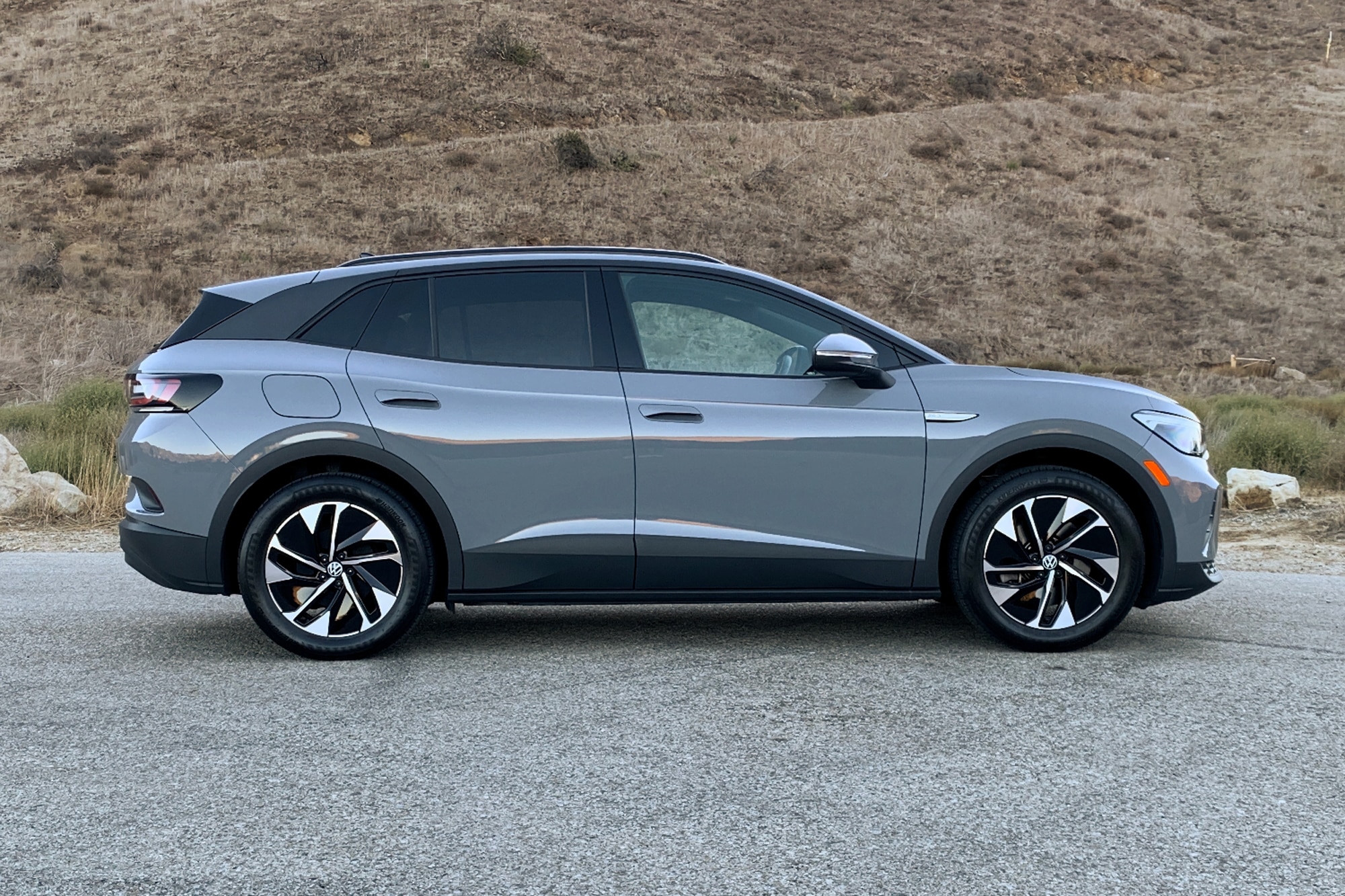 Christian Wardlaw
Christian Wardlaw
BROAD APPEAL MAKES ID.4 THE PEOPLE’S EV
There is no stopping them now: EVs are coming. And the 2021 Volkswagen ID.4 is among the first of a wave of models arriving in the U.S. market by 2025.
Based on experience driving most members of its competitive set, the Volkswagen ID.4 conveys a greater sense of refinement, sophistication, and style than the typical EV within its price point. Most likely, this is due to its bespoke vehicle platform, architecture, exclusive approach to controls, displays, and interior design compared to other Volkswagens.
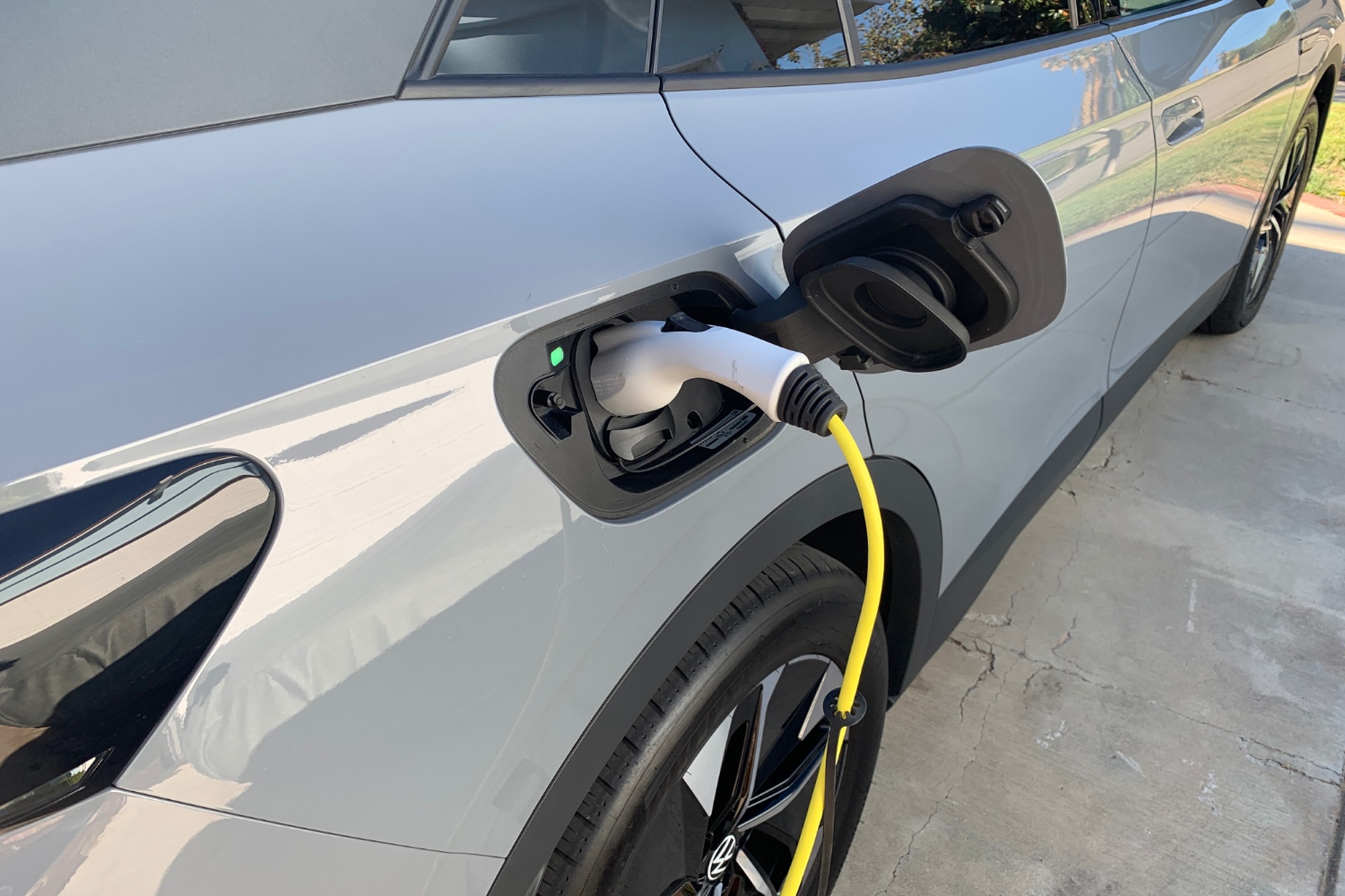 Christian Wardlaw
Christian Wardlaw
Beyond its inherent goodness, the Volkswagen ID.4 has a no-nonsense sensibility to it, much like the original Beetle that made Volkswagen a household brand and a pop-cultural icon. Although its bland crossover SUV shape doesn’t stand out as much as the air-cooled version of the flower power years, make no mistake; the ID.4 is no less revolutionary.
*Availability is subject to specific trim level selections
Written by humans.
Edited by humans.
 Christian Wardlaw
Christian WardlawChris says his first word was "car." For as long as he can remember, he's been obsessed with them. The design. The engineering. The performance. And the purpose. He is a car enthusiast who loves to drive, but is most passionate about the cars, trucks, and SUVs that people actually buy. He began his career as the editor-in-chief of Edmunds.com in the 1990s, and for more than 30 years has created automotive content for CarGurus, J.D. Power, Kelley Blue Book, the New York Daily News, and others. Chris owns Speedy Daddy Media, has been contributing to Capital One Auto Navigator since 2019, and lives in California with his wife, kids, dog, and 2004 Mazdaspeed Miata.
Related articles
View more related articles